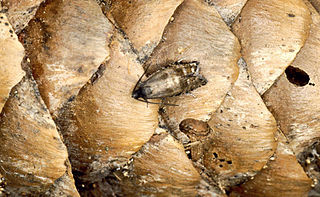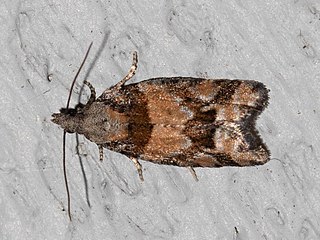Related Research Articles

A spruce is a tree of the genus Picea, a genus of about 35 species of coniferous evergreen trees in the family Pinaceae, found in the northern temperate and boreal (taiga) regions of the Earth. Picea is the sole genus in the subfamily Piceoideae. Spruces are large trees, from about 20 to 60 m tall when mature, and have whorled branches and conical form. They can be distinguished from other members of the pine family by their needles (leaves), which are four-sided and attached singly to small persistent peg-like structures on the branches, and by their cones, which hang downwards after they are pollinated. The needles are shed when 4–10 years old, leaving the branches rough with the retained pegs. In other similar genera, the branches are fairly smooth.

Picea abies, the Norway spruce or European spruce, is a species of spruce native to Northern, Central and Eastern Europe.

The pine beauty is a moth of the family Noctuidae. It is a common species of pine woods in Europe. The distribution area extends from Portugal to western Siberia, the Caucasus and Asia Minor. In the north it extends to the Arctic Circle, in the south it is found in Ceuta in Northern Africa in and southern Italy.

Picea obovata, the Siberian spruce, is a spruce native to Siberia, from the Ural Mountains east to Magadan Oblast, and from the Arctic tree line south to the Altay Mountains in northwestern Mongolia.

Spruce-pine-fir (SPF) is a classification of lumber that can be traded on commodities exchanges.

Cydia strobilella, the spruce seed moth, is a moth of the family Tortricidae. It is found in Europe.

Cydia pactolana, the spruce bark tortrix, is a moth of the family Tortricidae. It is found in central, northern and eastern Europe as well as Siberia. In Japan, the subspecies Cydia pactolana yasudai is present.

Cydia duplicana is a small moth of the family Tortricidae. It is found in all across Europe, extending barely into Asia in the Transcaucasus, Turkestan and Kazakhstan.

Cydia illutana is a small moth of the family Tortricidae. It is found from western and central Europe, north to Scandinavia and east to Russia (Siberia).

Epinotia radicana, the red-striped needleworm moth, is a species of moth of the family Tortricidae. It is found in western Canada, including British Columbia and Alberta.
Argyresthia laricella, the larch shoot moth, is a moth of the family Yponomeutidae. The species was first described by William D. Kearfott in 1908. It is found in Canada, including north-western Ontario, Nova Scotia, south-eastern Manitoba, Saskatchewan, western Alberta and southern British Columbia.
Argyresthia picea is a moth of the family Yponomeutidae. It is found in Canada, including Alberta, Ontario, Quebec and the Yukon.

Archips strianus, the striated tortrix moth or striated leafroller, is a species of moth of the family Tortricidae. It is found in North America, where it has been recorded from Alberta, British Columbia, Maine, Michigan, Minnesota, Montana, New Brunswick, Newfoundland, Ontario and Quebec.
Archips dissitanus, the boldly-marked archips moth, is a species of moth of the family Tortricidae. It is found in North America, where it has been recorded from Alberta to Nova Scotia and south to Minnesota and North Carolina in the Appalachian Mountains. The habitat consists of boreal forests.
Argyrotaenia occultana, the fall spruce needle moth, is a moth of the family Tortricidae. The species was first described by Thomas Nesbitt Freeman in 1942. It is found in North America, where it has been recorded from British Columbia north to Yukon and Northwest Territories, east to Newfoundland and south to Kentucky and Oregon. The habitat consists of spruce forests.
Choristoneura biennis, the two-year-cycle budworm moth, is a species of moth of the family Tortricidae. It is found in Canada, where it has been recorded from Alberta and British Columbia.

Conogethes pinicolalis is a moth in the diverse subfamily Spilomelinae of the family Crambidae. It was described by Hiroshi Inoue and Hiroshi Yamanaka in 2006, and is found in East and Southeast Asia, with records from Japan, Korea, China (Guangdong), Taiwan and Thailand.
References
- ↑ Inoue, Hiroshi; Yamanaka, Hiroshi (2006). "Redescription of Conogethes punctiferalis (Guenée) and descriptions of two new closely allied species from Eastern Palaearctic and Oriental Regions (Pyralidae, Pyraustinae)" (PDF). Tinea. Tokyo. 19 (2): 80–91.